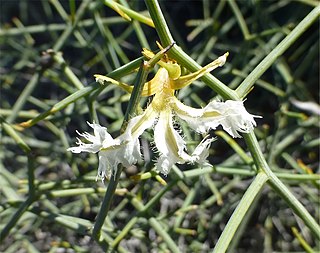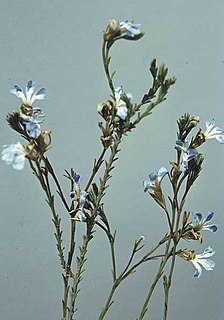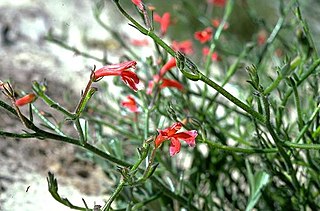
Lechenaultia is a genus of flowering plants in the family Goodeniaceae, the species native to Australia with one species also occurring in New Guinea. Plants in the genus Lechenaultia are glabrous shrubs or herbs with needle-shaped leaves, more or less sessile flowers with five sepals and five blue, white, or yellow and red petals in two unequal lobes, the fruit an elongated capsule.

Lechenaultia biloba, commonly known as blue leschenaultia, is a species of flowering plant in the family Goodeniaceae and is endemic to the south-west of Western Australia. It is a glabrous herb or subshrub with spreading branches, almost no leaves, and yellow, tube-shaped flowers.

Lechenaultia formosa, commonly known as red leschenaultia, is a species of flowering plant in the family Goodeniaceae and is endemic to the south-west of Western Australia. It is a prostrate or erect shrub or subshrub with crowded, narrow, fleshy leaves and scarlet or orange-red to pale orange flowers.

Lechenaultia divaricata, commonly known as tangled leschenaultia, wirenetting bush or wirebush, is a species of flowering plant in the family Goodeniaceae and is endemic to arid and semi-arid areas of central Australia.
Goodenia corralina is a species of flowering plant in the family Goodeniaceae and endemic to a restricted area near Norseman in Western Australia. It is a low, spreading, perennial, herb with linear to lance-shaped leaves in a rosette at the base of the plant, and racemes of yellow flowers.
Goodenia drummondii is a species of flowering plant in the family Goodeniaceae and is endemic to the south-west of Western Australia. It is an erect shrub with linear to lance-shaped stem leaves, and spike-like thyrses of small white flowers with purplish spots.
Goodenia hartiana, commonly known as Hart's goodenia, is a species of flowering plant in the family Goodeniaceae and is endemic to Western Australia. It is an erect to spreading perennial herb or subshrub with lance-shaped to egg-shaped leaves with the narrower end towards the base, racemes of blue or purple flowers and oval to cylindrical fruit.
Goodenia lancifolia, commonly known as scruffy goodenia, is a species of flowering plant in the family Goodeniaceae and is endemic to the far south-west corner of Western Australia. It is a perennial herb with linear to narrow egg-shaped at the base and stem-clasping, lance-shaped to egg-shaped stem-leaves and blue flowers with a white centre.
Goodenia salina is a species of flowering plant in the family Goodeniaceae and endemic to the south-west of Western Australia. It is an annual herb with lobed, oblong to lance-shaped leaves with the narrower end towards the base, arranged in a rosette at the base of the plant, and cymes of yellow flowers.

Goodenia scapigera, commonly known as white goodenia, is a species of flowering plant in the family Goodeniaceae and is endemic to the south-west of Western Australia. It is an erect, perennial herb or shrub with linear to narrow egg-shaped leaves clustered near the ends of the stems, and thyrses of white flowers with purplish spots.

Lechenaultia acutiloba, commonly known as wingless leschenaultia, is a species of flowering plant in the family Goodeniaceae and is endemic to the south-west of Western Australia. It is a dome-shaped shrub with crowded, linear leaves and many tube-shaped, pale greenish-yellow flowers with blue tips.
Lechenaultia aphylla is a species of flowering plant in the family Goodeniaceae and is endemic to arid parts of inland Australia. It is a glabrous herb or subshrub with spreading branches, almost no leaves, and yellow, tube-shaped flowers.
Lechenaultia brevifolia is a species of flowering plant in the family Goodeniaceae and is endemic to inland south-western Western Australia. It is a tufted, sparsely-branched subshrub with crowded, narrow, fleshy leaves and white and blue, tube-shaped flowers.
Lechenaultia chlorantha, commonly known as Kalbarri leschenaultia, is a species of flowering plant in the family Goodeniaceae and is endemic to a restricted area near Kalbarri in Western Australia. It is a subshrub or shrub with many branches, crowded, narrow, fleshy leaves and pale bluish-green, tube-shaped flowers.

Lechenaultia expansa is a species of flowering plant in the family Goodeniaceae and is endemic to the south-west of Western Australia. It is a prostrate to erect subshrub with wand-like branches, crowded, narrow, fleshy leaves and pale purple-blue, tube-shaped flowers.

Lechenaultia filiformis is a species of flowering plant in the family Goodeniaceae and is native to northern Australia and New Guinea. It is a grasslike, ascending herb with scattered, narrow, fleshy leaves and pale purple-blue to creamy-white, tube-shaped flowers.

Lechenaultia floribunda, commonly known as free-flowering leschenaultia, is a species of flowering plant in the family Goodeniaceae and is endemic to the south-west of Western Australia. It is an openly-branched shrub or subshrub with crowded, narrow, fleshy leaves and compact groups of pale blue to pale mauve or creamy white flowers.
Lechenaultia galactites, commonly known as white leschenaultia, is a species of flowering plant in the family Goodeniaceae and is endemic to the south-west of Western Australia. It is an erect, robust subshrub or shrub with crowded, narrowly oblong to egg-shaped leaves, and white to pale blue flowers.

Lechenaultia heteromera, commonly known as claw leschenaultia, is a species of flowering plant in the family Goodeniaceae and is endemic to the south-west of Western Australia. It is a subshrub with a few wand-like branches, fleshy leaves, and white and pale blue flowers.

Lechenaultia hirsuta, commonly known as hairy leschenaultia, is a species of flowering plant in the family Goodeniaceae and is endemic to the west of Western Australia. It is a straggling, low-lying shrub with few branches, fleshy leaves, and scarlet flowers.












